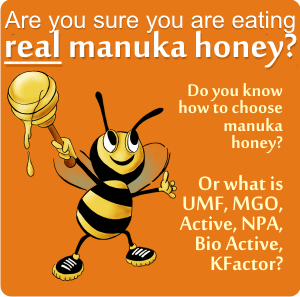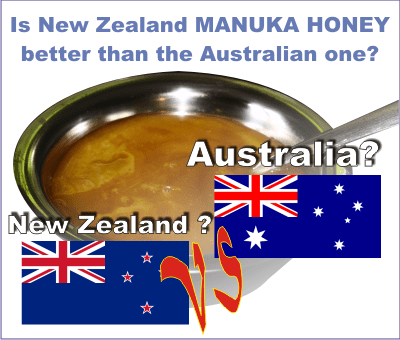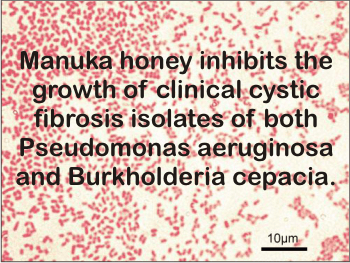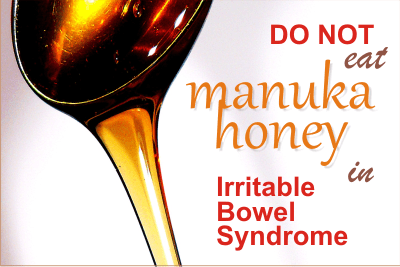Somebody asked me why New Zealand manuka honey is better than Australian manuka honey. The question was raised probably because of the general recommendation which is to buy manuka honey produced and packed in New Zealand. Not in Australia. So, why the difference?
After decades of research on the properties of manuka honey, New Zealanders have managed to share the incredible health benefits that manuka honey can bring to the world. And this raised their GDP A LOT! Manuka honey is six times the cost of conventional honey!
Now, manuka honey is not produced only in New Zealand, but also in Australia. Even more, it is said that the tree itself was brought by the Tasmanian winds from Australia, and so they are more entitled to represent this tree.
Why are the Australians claiming their manuka honey is as good if not better than NZ manuka honey?
And why are they saying this now, after so many years?
Because manuka honey is expensive and the large exports have brought them an increase in their GDP.
In 2017 there are about 12,400 registered beekeepers in Australia, and about 200,000 hives used for commercial pollination and honey production. The industry produces up to 30,000 tonnes of honey annually. Australians say that manuka varieties in Australia are just as active as those in New Zealand, and have essentially the same chemical profile, and this may add significant value to Australian honey for beekeepers and provide a plentiful supply of medicinal honey.
In NZ the price of manuka honey per kilogram is 5 to 10% higher than its equivalent in Australia. Why wound’t Australians raise the price of the same product and thus raise their GDP, too?
Is it fair?
The research on manuka honey and all the advertising has been done by the New Zealanders. They are the ones that have conducted hundreds of studies to better understand and use manuka honey. They have created specific tests to be done and laws to be respected so their customers can enjoy a quality honey. They have created associations to take care of these all.
They have invested serious money in advertisement and made the product available around the globe. I do believe that it is their right to benefit from the fruit of their work.
But than, is life fair?
Why do NZs insist that we should buy only manuka honey from New Zealand?
Because they can vouch only for the quality of the manuka honey produced and packed in their country. Otherwise they risk a decrease in its reputation as a medical trusted product, which will lead to fewer medical problems solved and, of course, less profit.
Is it possible for Australian manuka honey to be better?
Sure it is. The source tree of this honey is manuka tree, on its botanically name Leptospermum scoparium, found in large areas in Australia, too.
In fact, in Australia there are 83 species of tree belonging to the family Leptospermum, clearly the mother of this family tree, while in NZ there are only 2 Leptospermum species.
If we call all the Leptospermum trees manuka trees, as it seem to be the case within the Australian claims, then they clearly have a wide variety of manuka honeys, possibly of a higher quality.
But the NZ says only manuka honey that is made from the nectar of L. scoparium can be named manuka honey. We do know that there are other types of Leptospermum honey in Australia bearing different names. The case of Berringa honey, which is produced from L. polygalifolium aka jelly bush or the lemon-scented tea tree.
Aren’t all Leptospermum trees the same?
No. And the honey resulted is different. Their specific characteristics are studied to see if the honey is genuine monofloral manuka in the first place and secondly to see if it is antimicrobial active (has medical value). For this they have to research the content of methylglyoxal (MGO), dihydroxyacetone (DHA) and Leptosperin.
A 2015 study, by Amanda M. Norton et al., showed that the DHA content may defer a lot among the different species of Leptospermum trees.
– In L. whitei and L. polygalifolium samples, DHA/sugar ratios ranged from 10169 to 24199 ppm and from 9321 to 20174 ppm, respectively.
– In L. laevigatum and L. trinervium samples, DHA was undetected. – this nectar will give non-active honey.
Not all species of Leptospermum produce active honey.
To see the differences between the trees, here is a representative study: Not all Leptospermum Are Equal. Keep in mind that seasonal weather is the governing factor of yield nectar.
Do we have scientific proof that the Australian honey is as good as the NZ honey?
Not yet, but someday. Be patient.
In 2014 a team of Australian researchers have started a study to compare the qualities of their manuka honey to those of the NZ corespondent. The research team includes Professor Liz Harry, Dr Shona Blair and Dr Nural Cokcetin (ithree institute, University of Technology Sydney), as well as Dr Peter Brooks and Simon Williams (University of Sunshine Coast) and Professor Dee Carter (University of Sydney).
The project is being funded by the Rural Industries Research and Development Corporation (RIRDC), with some support from Capilano (Australia’s largest honey producer) and Comvita (New Zealand’s Medicinal honey producer), and will run until 2019.
For the first 3 years they are asking beekeepers with access to Leptospermum honeys from anywhere in the country, to provide samples to be included in this research project, until a certain date in 2017. The honey will be tested for its antimicrobial activity and the relationship between this activity and the plant source will be investigated.
All the results are confidential (so please but jump into conclusions!) and the beekeepers will receive the results of their honey samples.
By May 2017 there had been collected 826 honey samples.
People are saying that in Dec 2016 – the research team said that Australian manuka honey is at least as powerful against bacteria as New Zealand manuka honey. I personally haven’t found an official statement, especially that they announced the data are confidential until the final results.
What do they know for sure?
– That a handful of Australian Leptospermum honeys have similar levels of antibacterial activity to New Zealand manuka. Some of them have even higher quantities of methylglyoxal (MGO) – the emblematic antibacterial compound found in manuka honey. Is the case of honey produced from Australian Leptospermum polygalifolium, also known as jelly bush or the lemon-scented tea tree, which has been found to contain up to 1750 mg/kg of MGO. (Australians call this honey Super Manuka Honey, aka Berringa honey.)
But most of the other 80+ Australian Leptospermum varieties have not been tested.
– Leptospermum scoparium, the species found in NZ, also occurs in New South Wales, Victoria, Tasmania, so the honey produced from it should be approximately the same as the one produced in NZ. More studies are required.
– Concentrations above 263 milligrams a kilogram of methylglyoxal are considered useful for medical purposes. More than half (45) of the 80 Australians samples tested by now were of this quality.
Of these 80 Australian honeys tested, 22 were at least as active as the New Zealand honeys and 12 of them had methylglyoxal concentrations above 800 mg a kilogram, among the highest concentrations achievable.
We still wait for the final results in 2019.
What is the purpose of the study?
1. to find more sources of active honey
2. to help the Australian beekeeping industry by increasing the amount and value of medicinal Australian honey. If they discover Australian honey si as good as NZ’s, the price for the Australian honey will increase by 50% per year.
Where can we see the results of the study?
You can stay updated with the work at the project on their website ozhoneyproject.wordpress.com
How do the New Zealanders protect their honey?
 They want to make manuka honey their brand. They want to secure it with a similar protection granted to other products around the world such as: French Champagne, Scottish Whisky and Cornish Pasties.
They want to make manuka honey their brand. They want to secure it with a similar protection granted to other products around the world such as: French Champagne, Scottish Whisky and Cornish Pasties.
The UMF Honey Association (UMFHA) has initiated a legal application with the New Zealand Intellectual Property Office for a certification trademark, which would secure the name “Manūka Honey” internationally.
This is being filed under the auspices of the Manuka Honey Appellation Society Incorporated (MHAS). This Society was established with the sole purpose of ensuring that ownership of the name Manuka Honey was secured for New Zealand honey producers and the wider industry as a whole.
On 27th September 2016, The UMFHA posted The Certification Trademark for the descriptor ‘Manuka Honey’ in its Members Update, for everybody to read.
Here are some of their reasons for this request:
1. Leptosperin is a complex compound found in L scoparium from both NZ and Australia, as it was proved in 2014 by the Japanesse researcher Yoji Kato. But although the tree is the same, the nectar yield is different due to different environmental conditions.
“The environment definitely changes things.” says John Rawcliffe, the administrator of UMF Honey association from NZ. According to him the discrepancies between the soil, light, and weather in Australia and New Zealand make a difference in the quality of the honey—just as they do with wine. “The wine out of Napa Valley is completely different from the wine out of New Zealand,” Rawcliffe says.
He cites a study published by the New Zealand Journal of Botany which shows that the overall manuka nectar yield is influenced by cultivar and soil interaction.
2. They say manuka honey from NZ is different. It is sourced only of the leptospermum scoparium var scoparium.
According to New Zealand Plant Conservation Network, most Australian forms of L. scoparium do not match the range seen in New Zealand.
However, plants from Tasmania are very similar to, if not identical with some South Island forms, differing mainly by their wider leaf base, and longer, more pungent leaf apex. Manuka was also collected once from Rarotonga by Thomas Cheeseman in the 1800s. It has not been found there since, and is assumed to have been a failed introduction.
NZPCN says further study using DNA sequencing is underway to resolve the status of L. scoparium forms both NZ and Australia.
3. Manuka (pronounced: ma-NOO-ka, MAH-nuh-ka) is a Maori word that is universally used within New Zealand for the Leptospermum scoparium tree and it should be protected for the benefit of all New Zealanders.
The Maori name associated with manuka: MĀNUKA, KAHIKĀTOA; kātoa, pata, rauwiri, rauiri – commonly called Tea Tree because early colonists used its aromatic foliage as an alternative to tea.

Manuka was also the name of one of the great ocean-going canoes which brought the Maoris to New Zealand.
4. Manuka honey is today recognized worldwide as a good functional food and in the medical world as a powerful antibacterial agent due to NZ research and marketing. “People have come to appreciate Manuka Honey as being a distinctive honey from New Zealand that has unique attributes and benefits.”
“It is vital that we safeguard this heritage and the provenance of such an iconic honey which is so intrinsically identified as being from New Zealand.”
If the application succeeds, New Zealanders will have exclusive use of the international brand, in the same way that only sparkling wine from a certain region of Northern France can legally be called champagne.
In the end NZ doesn’t say the Australian Leptospermum honey does not have high medical qualities. What they say is that they have the right on the words “manuka honey” and the Australian honey should be called, as many of their people already do, Jelly bush honey.
What do Australian beekeepers say?
Some say their manuka honey is just as good if not better. But some others want to secure a future profit and make some investments in manuka trees brought from New Zealand, with the purpose of recreating the product made from the original New Zealand species Leptospermum tree.
Perth businessman Paul Callander has imported Leptospermum seed varieties from the north island of New Zealand into Western Australia and is growing one million trees in a Manjimup nursery in the south-west of the state. He and his colleagues were in the process of planting those trees in June 2016.
Why? Because until the Australian honey will be recognized as medical too, manuka honey is worth between $40/kilo and $100/kilo, much more than the standard price of $5.50/kilo for West Australian honey.
Beekeeper Brendan Fewster said if the plants did grow and flower successfully, the manuka industry could be a goldmine for local honey producers. Especially because Australia has a reputation for having some of the healthiest bees in the world. They are not facing Collony Collapse Disorder, their bees don’t have varoa mites – a really great problem for the NZ beekeepers. (source)
Besides this financial reason, let’s not forget that Australians have other exceptional honeys such as honeys sourced in marri (Corymbia calophylla), jarrah (Eucalyptus marginata) and jellybush (Leptospermum polygalifolium). Or their unique and delicious Tasmanian leatherwood honey.
There is a city in Australia called Manuka
An area of the Australian city of Canberra is called Manuka after the tree. It has a different pronunciation than the tree. It’s /ˈmɑːnəkə/ (locally [ˈmɐːnəkə]) compared to /mɑːnuːkə/ ([mɐːˈnʉːkə]) for the tree.
There are Manuka Shops, Manuka Oval, Manuka Swimming Pool, and Manuka Circle taking their name from the park in the area.
Did you know?
Oz – refers to Australia. Yet only foreigners call it like that? (I don’t know if its a short from the phonetic “Oztreilia” or because the wizard lived there…) Its residents are called Aussies.
 Kiwi – refers to a person from New Zealand. The name comes from their national bird, kiwi, which has nothing to do with the common fruit, kiwifruit. The bird lives only here, it doesn’t fly and is a bit blind, comes out only at night, shuffles around and is kind of anti-social. Yet, New Zealanders treasure it lot, as their own “brand”.
Kiwi – refers to a person from New Zealand. The name comes from their national bird, kiwi, which has nothing to do with the common fruit, kiwifruit. The bird lives only here, it doesn’t fly and is a bit blind, comes out only at night, shuffles around and is kind of anti-social. Yet, New Zealanders treasure it lot, as their own “brand”.
And no, I don’t think the people of NZ are anything like these birds and I don’t know why Australians mostly hate them all…
====================
====================
References:
https://en.wikipedia.org/wiki/Manuka,_Australian_Capital_Territory
http://www.nzpcn.org.nz/flora_details.aspx?ID=2302
kiwi crossing sign – picture credit The.Rohit via flickr.com




